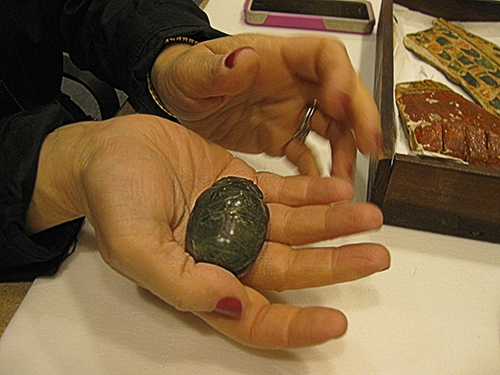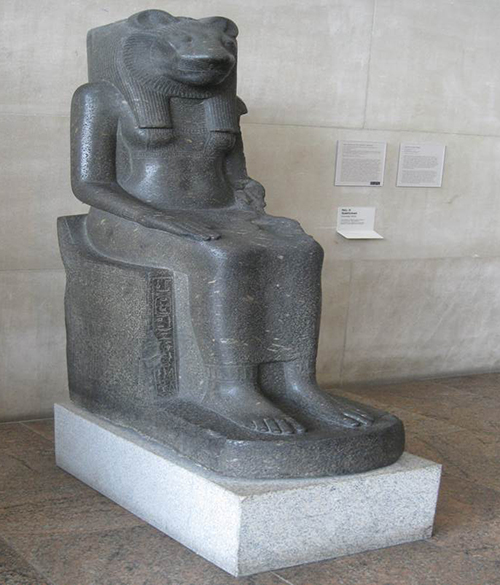Each year at its leadership conference, the American Foundation for the Blind (AFB) bestows Access Awards to the individuals, companies, and organizations that go above and beyond when it comes to improving accessibility for people with vision loss. Among the honorees for 2014 is the Metropolitan Museum of Art, also known as the Met.
A Bit of History
The Met, which is composed of the main building on Fifth Avenue, and The Cloisters museum and gardens in northern Manhattan, traces its origins to 1866, when a group of Americans in Paris, France, agreed to create a "national institution and gallery of art" to bring art and art education to the American people.
According to its website, The Metropolitan Museum of Art was founded on April 13, 1870, "to be located in the City of New York, for the purpose of establishing and maintaining in said city a Museum and library of art, of encouraging and developing the study of the fine arts, and the application of arts to manufacture and practical life, of advancing the general knowledge of kindred subjects, and, to that end, of furnishing popular instruction."
This statement of purpose has guided the Museum for more than a century.
The Trustees of The Metropolitan Museum of Art have reaffirmed the statement of purpose and supplemented it with the following statement of mission:
The mission of The Metropolitan Museum of Art is to collect, preserve, study, exhibit, and stimulate appreciation for and advance knowledge of works of art that collectively represent the broadest spectrum of human achievement at the highest level of quality, all in the service of the public and in accordance with the highest professional standards.
The Met Today
Today, the museum's two-million-square-foot main building houses over two million objects, tens of thousands of which are on view at any given time, and it hosts approximately 6.2 million patrons annually from around the world.
AccessWorld recently toured the Met to bring our readers firsthand information about its access efforts. Rebecca McGinnis, the Met's enthusiastic and knowledgeable Museum Educator, oversees its Access and Community Programs and acted as our tour guide. McGinnis is partially sighted. She holds a master's degree in Art History and another in Museum Studies, and she is currently working on her PhD in Cognitive Psychology.
As we began the tour McGinnis stated, "The Met now has an array of offerings. We feel it's really important to offer choice. The museum wants people to connect with art in whatever way that interests them, whether it's making art or learning about art in the galleries through touch and description. Some programs are scheduled, where people can come to meet with others and have a social experience, and we offer touch and descriptive tours by request." When staff members conduct these tours, there is a dialogue between the patron and the tour guide. During this conversation, the patron can ask questions and make choices, and the guide can tailor the tour towards the patron's interests.
In most art museums, people are not permitted to touch art or artifacts on display, but at the Met, there are numerous items that may be touched.
The Met's Touch Collection was established in the 1970s, and it currently consists of approximately 130 unique objects, representing most of the museum's departments. McGinnis once found a museum bulletin from the early 1900s that indicated that, even then, there were tours and talks specifically for the blind.
McGinnis was kind enough to show us several touchable artifacts, including a variety of small sculptures. She described each piece in great detail, telling us what it was, its approximate age, and what it was made from. Here are just a few of the touchable artifacts that were included in our private tour:
- An early 20th-century Inuit soapstone sculpture from either Alaska or Northern Canada. The mother and child are facing each other with the mother's hands outstretched and the child's hands across his chest.
- A fragment—a foot in a sandal—from an ancient Roman marble statue,
- A 3,500-year-old piece of a mummy's wrapping made of gauze and resin.
- A carved scarab with hieroglyphics. The scarab was placed on a mummy's chest before wrapping.
Caption: A closeup of the carved scarab in a visitor's hand
The Egyptian Touch Tour is one such tour that does not require an advance reservation. At this time, three to six artifacts in this particular collection can be touched. These include two sarcophagi (Egyptian caskets) and a statue. McGinnis is currently working on updating the descriptive book that goes along with the tour. The updated book will have braille, large print, and tactile graphics. She added that the museum is working to set up additional touch tours that will not require reservations.
Caption: Statue of the goddess Sakhmet, featured on the Egyptian Touch Tour
Like many museums, the Met has an audio guide, which is free for people with visual impairments.
McGinnis is also working closely with the staff in the Met's Digital Media department to develop new ideas to make sure that all digital media is accessible. She added that she is working with the developer of the Met app, explaining, "We're using the development of that app as a pilot to develop a process to insure that future digital media projects are accessible to people with little or no vision."
The Met has a wonderful children's book entitled, Art and the Alphabet: A Tactile Experience, co-authored by McGinnis. The book incorporates braille and print and features art from the museum's collection. Each page has a tactile representation of the print letter and a tactile representation of the artwork that goes with each letter.
Additional Programs for People with Visual Impairments
The Met offers programs for all ages, from preschoolers to senior citizens.
Picture This!
Picture This! is a monthly program designed for people with visual impairments. The program focuses on special exhibitions primarily made accessible through verbal descriptions. Other techniques used include touch and conversations with a curator.
Picture This! Family
Picture This! Family is open to visually impaired children and their families. McGinnis explained, "We use a lot of hands-on materials which connect to how art is made. The combination of touch and making art, with supportive description and conversation, is how we approach family programs with children."
Seeing Through Drawing
Seeing Through Drawing is a monthly class open to anyone with vision loss. Emphasis is on the act of drawing and the feel of different materials rather than the final product. Sometimes the class touches objects that they then draw, and other times, they bring drawing boards into a gallery and draw from a description. Sometimes they draw as a response to sound or music. The class meets one Saturday per month, and pre-registration is not required. The class is taught by two artists and is usually attended by 15 to 20 people. The instructors for this class also teach at local colleges and often employ the same teaching techniques with their sighted students.
Special Events
The Met has many special events open to the general public. You can join a mailing list specifically for notifying people who have visual impairments when accessible events are scheduled. For example, an accessible event may include features such as audio description, tactile exploration, or exploring different scents.
In addition to programs for people with vision loss, the Met offers programs for people with other disabilities including hearing loss, developmental or learning challenges, and dementia. You can visit the museum's accessibility page for more information on these offerings.
Teaching about Museum Accessibility
Last fall, McGinnis and the director of the Met's media lab worked with a professor from the Parsons School of Design in New York to develop a graduate-level lab course on museums, technology, and accessibility. McGinnis said, "I established a group of advisors with different disabilities who are museum goers. The advisors talked about their experiences in museums: what they liked, what works for them, what doesn't, and what access and mainstream technologies they use." Throughout the semester, those advisors worked with the graduate students, and helped them with their projects by providing user testing and general feedback. In addition to the advisors, the students also worked with access technology experts and museum staff.
During the semester, the graduate students divided themselves into four groups based on their interests. One group developed a way finding app for the museum. The second group evaluated the Met's website and developed and implemented new code to improve the screen reader experience; drafted some guidelines for art museum websites and for creating descriptive alt tags; looked at optimizing the Met's website for people with low vision; and developed an eye-tracking device for people who are non-verbal and/or have dementia. The fourth group laser cut a raised copy of Picasso's painting of Gertrude Stein and added audio content into the painting.
McGinnis explained the range of, and need for, the class this way: "The graduate students learned about museums, the needs of people with disabilities, and how to create accessible technology that will help museum patrons access art. Most of the students were working toward a Masters of Fine Arts in the Design and Technology program, yet none of them had heard of universal design."
A Continued Commitment to Access
Through fellowships and professional exchanges, ongoing excavation work, traveling exhibitions, and many other initiatives, the Museum continues in the twenty-first century to fulfill its mission and serve the broadest possible audience. AFB and AccessWorld once again commend the Metropolitan Museum of Art for taking a proactive stance and continuing to improve upon access to its collections for people with vision loss and all disabilities. If you live in or are traveling to the New York City area, we urge you to visit the Metropolitan Museum of Art. We also encourage other museums across the country to follow the Met's example and improve upon the accessibility of their art collections.
Hours of Operation and Contact Information
Hours: Open 7 days a week, except closed Thanksgiving Day, December 25, January 1, and the first Monday in May.
Sunday—Thursday: 10 am—5:30 pm
Friday and Saturday: 10 am—9 pm
Contact Information:
The Metropolitan Museum of Art
1000 Fifth Avenue
New York, NY 10028
Telephone: 212.650.2070
Accessibility Information:
To arrange a tour or to get on the mailing list for programs for the visually impaired:
Phone: 212-650-2010
Email: access@metmuseum.org
Website for information about programs for people with visual impairments.

